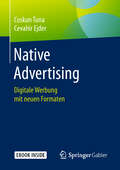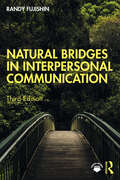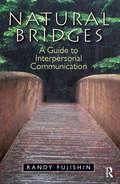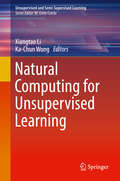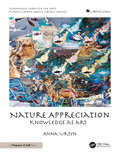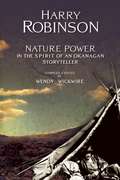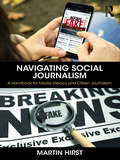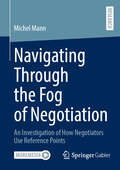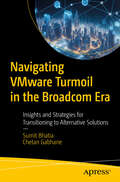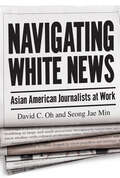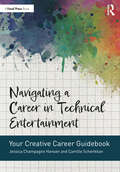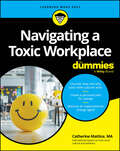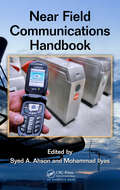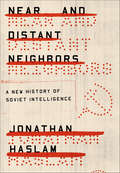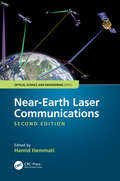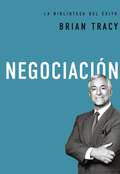- Table View
- List View
Native Advertising: Digitale Werbung Mit Nativen Kampagnen
by Coskun Tuna Cevahir EjderDieses Buch erklärt kompakt und auf den Punkt, was Native Advertising ist, wie diese neue Werbedisziplin funktioniert und welche Vorteile sie Werbungtreibenden bietet. Die Autoren – selber Vorreiter in dieser jungen Branche – geben einen aktuellen Überblick mit wichtigen Daten und Fakten, erklären alle nativen Werbeformate im Detail und beschreiben die Technologien sowie die durchaus kontrovers diskutierten Rollen der einzelnen Player dabei: Publisher, Advertiser und Konsumenten.Ein Praxisleitfaden für alle, die an Online-Werbung jenseits von Bannern und Rectangles interessiert sind, um ihren Produkten mit sensibel gestalteten und gut ausgesteuerten nativen Kampagnen mehr Glaubwürdigkeit und Sympathie zu verleihen.
Natural Bridges in Interpersonal Communication
by Randy FujishinRandy Fujishin’s Natural Bridges in Interpersonal Communication, Second Edition is a concise, practical, and reader-friendly book that introduces students to the basic concepts and skills of interpersonal communication. The book presents the fundamental tools necessary to effectively communicate in face-to-face and online interactions in personal and professional life settings. Fujishin’s approachable writing style engages students, inviting them to consider how best to approach their own opportunities to communicate with others. New to this edition, each chapter includes a discussion of foundational research, with suggestions for further reading and online resources. This textbook is designed for Communication Studies, Business, and Career and Trade courses at the community college and four-year university level. Online instructor materials that accompany the book include an instructor manual, sample exams, and a sample class schedule. <P><P><i>Advisory: This book offers only partial accessibility. We have kept it in the collection because it is useful for some of our members. Benetech is actively working on projects to improve accessibility issues such as these in the future.</i>
Natural Bridges in Interpersonal Communication
by Randy FujishinWith a particularly student-friendly and engaging style, this third edition gives readers the fundamental tools necessary to effectively communicate in interpersonal interactions. Natural Bridges in Interpersonal Communication, Third Edition, is a concise and practical book that introduces students to the basic concepts and skills of interpersonal communication in both face-to-face and online interactions in personal and professional settings. Each chapter features human interest stories and review exercises to help students better understand the concepts covered. This edition continues its expanded coverage of foundational research and devotes additional space to discussions of cultural safety, race and ethnicity, issues of mental health, and technology and social media. This textbook is designed for communication studies, business, and career and trade courses in interpersonal communication and communication skills at the community college and four-year university levels. Online instructor materials that accompany the book include an instructor’s manual, sample exams, and a sample class schedule. They are available at www.routledge.com/9781032355054.
Natural Bridges: A Guide to Interpersonal Communication
by Randy FujishinNatural Bridges is a concise, practical, inexpensive, and student-friendly guide to interpersonal communication. This book explores the fundamental principles and skills necessary for effective communication. Building on the theme that our every word and behavior contributes to building a bridge or a barrier in our daily interactions with others, Natural Bridges provides students with concepts and real-world guidelines for productive communication with acquaintances, friends, family-members, romantic partners, and co-workers.
Natural Computing for Unsupervised Learning (Unsupervised and Semi-Supervised Learning)
by Ka-Chun Wong Xiangtao LiThis book highlights recent research advances in unsupervised learning using natural computing techniques such as artificial neural networks, evolutionary algorithms, swarm intelligence, artificial immune systems, artificial life, quantum computing, DNA computing, and others. The book also includes information on the use of natural computing techniques for unsupervised learning tasks. It features several trending topics, such as big data scalability, wireless network analysis, engineering optimization, social media, and complex network analytics. It shows how these applications have triggered a number of new natural computing techniques to improve the performance of unsupervised learning methods. With this book, the readers can easily capture new advances in this area with systematic understanding of the scope in depth. Readers can rapidly explore new methods and new applications at the junction between natural computing and unsupervised learning. Includes advances on unsupervised learning using natural computing techniquesReports on topics in emerging areas such as evolutionary multi-objective unsupervised learning Features natural computing techniques such as evolutionary multi-objective algorithms and many-objective swarm intelligence algorithms
Natural Disaster: I Cover them. I am one.
by Ginger ZeeGinger grew up in small-town Michigan where she developed an obsession with weather as a young girl. Ginger opens up about her lifelong battle with crippling depression, her romances that range from misguided to dangerous, and her tumultuous professional path.
Natural Language Processing with Flair: A practical guide to understanding and solving NLP problems with Flair
by Tadej MagajnaLearn how to solve practical NLP problems with the Flair Python framework, train sequence labeling models, work with text classifiers and word embeddings, and much more through hands-on practical exercisesKey FeaturesBacked by the community and written by an NLP expertGet an understanding of basic NLP problems and terminologySolve real-world NLP problems with Flair with the help of practical hands-on exercisesBook DescriptionFlair is an easy-to-understand natural language processing (NLP) framework designed to facilitate training and distribution of state-of-the-art NLP models for named entity recognition, part-of-speech tagging, and text classification. Flair is also a text embedding library for combining different types of embeddings, such as document embeddings, Transformer embeddings, and the proposed Flair embeddings.Natural Language Processing with Flair takes a hands-on approach to explaining and solving real-world NLP problems. You'll begin by installing Flair and learning about the basic NLP concepts and terminology. You will explore Flair's extensive features, such as sequence tagging, text classification, and word embeddings, through practical exercises. As you advance, you will train your own sequence labeling and text classification models and learn how to use hyperparameter tuning in order to choose the right training parameters. You will learn about the idea behind one-shot and few-shot learning through a novel text classification technique TARS. Finally, you will solve several real-world NLP problems through hands-on exercises, as well as learn how to deploy Flair models to production.By the end of this Flair book, you'll have developed a thorough understanding of typical NLP problems and you'll be able to solve them with Flair.What you will learnGain an understanding of core NLP terminology and conceptsGet to grips with the capabilities of the Flair NLP frameworkFind out how to use Flair's state-of-the-art pre-built modelsBuild custom sequence labeling models, embeddings, and classifiersLearn about a novel text classification technique called TARSDiscover how to build applications with Flair and how to deploy them to productionWho this book is forThis Flair NLP book is for anyone who wants to learn about NLP through one of the most beginner-friendly, yet powerful Python NLP libraries out there. Software engineering students, developers, data scientists, and anyone who is transitioning into NLP and is interested in learning about practical approaches to solving problems with Flair will find this book useful. The book, however, is not recommended for readers aiming to get an in-depth theoretical understanding of the mathematics behind NLP. Beginner-level knowledge of Python programming is required to get the most out of this book.
Nature Appreciation: Knowledge as Art
by Anna UrsynIf asked what all people can agree with, we can see one answer: we all love Nature, one way or another. In this book, impossible creatures (one can perceive as atoms, molecules, or minerals) playfully deliver computer codes, with an underlying notion that everything is connected: in nature, materials, sciences, techniques, computing, and the arts. In this innovative space, these characters introduce programming. While coding is intertwined into simple facts, Nature Appreciation shows ways we appreciate nature, thus, helping us learn in a playful, nonjudgmental way.Knowledge is divided into subjects and classes at schools, colleges, then universities. Facts, processes, and rules cannot be separated. They are all connected: biochemistry, product materiality changes from matter to energy and vice versa, and conversion of one state into another. In this book, they are considered as different ways of living, such as: Geo, earth, soil, minerals, and natural resources experienced when walking on the ground. Water, transportation, ecosystems, leisure time, and energy related to water environs. Air, energy, space and planets travel, galatic objects, space junk. One can fly or carry materials and devices through it. Waves, communication, transformation, music, light, color - everything related to light, electromagnetic waves, oscillation, and vibration. Also Visually Static World, Space Exploration, and Deep Underwater are also included. It is a part of the “Knowledge Through the Arts” series, consisting of:Dance Code - Dance Steps as a CodeNew Storytelling - Learning Through MetaphorsCode Appreciation - Reshaping KnowledgeNature Appreciation - Knowledge as Art
Nature Inspired Computing for Wireless Sensor Networks (Springer Tracts in Nature-Inspired Computing)
by Debashis De Nilanjan Dey Amartya Mukherjee Santosh Kumar DasThis book presents nature inspired computing applications for the wireless sensor network (WSN). Although the use of WSN is increasing rapidly, it has a number of limitations in the context of battery issue, distraction, low communication speed, and security. This means there is a need for innovative intelligent algorithms to address these issues.The book is divided into three sections and also includes an introductory chapter providing an overview of WSN and its various applications and algorithms as well as the associated challenges. Section 1 describes bio-inspired optimization algorithms, such as genetic algorithms (GA), artificial neural networks (ANN) and artificial immune systems (AIS) in the contexts of fault analysis and diagnosis, and traffic management. Section 2 highlights swarm optimization techniques, such as African buffalo optimization (ABO), particle swarm optimization (PSO), and modified swarm intelligence technique for solving the problems of routing, network parameters optimization, and energy estimation. Lastly, Section 3 explores multi-objective optimization techniques using GA, PSO, ANN, teaching–learning-based optimization (TLBO), and combinations of the algorithms presented. As such, the book provides efficient and optimal solutions for WSN problems based on nature-inspired algorithms.
Nature Power
by Harry Robinson Wendy WickwireMany of the stories in Okanagan storyteller Harry Robinson's second collection feature the shoo-MISH, or "nature helpers" that assist humans and sometimes provide them with special powers. Some tell of individuals who use these powers to heal themselves; others tell of Indian doctors with the power to heal others. Still others tell of power encounters of various kinds.
Nature-Inspired Computing for Smart Application Design (Springer Tracts in Nature-Inspired Computing)
by Santosh Kumar Das Thinagaran Perumal Thanh-Phong DaoThis book focuses primarily on the nature-inspired approach for designing smart applications. It includes several implementation paradigms such as design and path planning of wireless network, security mechanism and implementation for dynamic as well as static nodes, learning method of cloud computing, data exploration and management, data analysis and optimization, decision taking in conflicting environment, etc. The book fundamentally highlights the recent research advancements in the field of engineering and science.
Navigating Social Journalism: A Handbook for Media Literacy and Citizen Journalism
by Martin HirstPublic trust in the once powerful institutions of the News Establishment is declining. Sharing, curating and producing news via social media channels may offer an alternative, if the difficult process of verification can be mastered by social journalists operating outside of the newsroom. Navigating Social Journalism examines the importance of digital media literacy and how we should all be students of the media. Author Martin Hirst emphasizes the responsibility that individuals should take when consuming the massive amounts of media we encounter on a daily basis. This includes information we gather from online media, streaming, podcasts, social media and other formats. The tools found here will help students critically evaluate any incoming media and, in turn, produce their own media with their own message. This book aims both to help readers understand the current state of news media through theory and provide practical techniques and skills to partake in constructive social journalism.
Navigating Through the Fog of Negotiation: An Investigation of How Negotiators Use Reference Points
by Michel MannNegotiations are an integral part of our daily lives, but they can also be challenging and complex. To successfully navigate the fog of negotiation, people rely on reference points—comparison standards for evaluating potential and final negotiation outcomes. They enable negotiators to make smart decisions and take effective action despite difficult circumstances. But how do these reference points emerge? What functions do they serve in negotiations? And how can they be utilized to shape outcomes? This book delves into the psychology of reference points in negotiations, exploring how they influence decision-making, behavior and negotiated outcomes. By uncovering their mechanisms, this work provides insights for understanding, predicting and refining negotiation techniques—essential knowledge for researchers, professionals and anyone aiming to negotiate more effectively.
Navigating VMware Turmoil in the Broadcom Era: Insights and Strategies for Transitioning to Alternative Solutions
by Sumit Bhatia Chetan GabhaneFor the past two decades, VMware has dominated the infrastructure virtualization space, with organizations relying heavily on its ESXi platform for virtualizing their environments. However, the recent takeover of VMware by Broadcom has brought unprecedented changes that have unsettled the industry. These changes include the end of perpetual licenses, alterations to the licensing model requiring a minimum purchase of 16 cores, termination of existing contracts, and a significant increase in licensing costs. Such developments have posed challenges for numerous organizations worldwide. As cloud modernization gains momentum, organizations are gradually reducing their dependence on on-premises infrastructure. While cloud adoption is on the rise, certain factors such as compliance, security, and legal restrictions necessitate the retention of specific resources on-premises. Despite the growing cloud trend, VMware remains the preferred choice for many specialists due to its longstanding presence. However, Broadcom&’s actions to exploit this niche hosting requirement by significantly raising product costs have left many organizations feeling betrayed and actively seeking alternatives. This book provides objective insights to help organizations break free from vendor lock-in and navigate the changing landscape. It delves into the ruthless changes introduced by Broadcom to VMware and discusses the challenges of transitioning to alternatives. By offering a practical understanding of various available options, including emerging virtualization technologies, the book empowers industry experts to manage their existing dependence on VMware effectively. Real-world case studies and examples further reinforce the argument for adopting diverse VMware alternatives tailored to the unique settings of each organization. What You Will Learn Review the unprecedented changes brought about by Broadcom&’s takeover of VMware, including the termination of perpetual licenses, alterations to licensing models, and substantial increases in licensing costs. Understand the evolving landscape of virtualization technology and the challenges organizations face in transitioning away from VMware. Study the practical strategies and emerging virtualization technologies available as alternatives to VMware. Who This Book Is For IT architects, Admins, Technical Managers, CTOs, and Infrastructure solution experts.
Navigating White News: Asian American Journalists at Work
by David C Oh Seong Jae MinCombining critical race studies with cultural production studies, Navigating White News: Asian American Journalists at Work is the only academic book to examine the ways that racial identification and activation matters in their understanding of news. This adds to the existing literature on race and the sociology of news by examining intra-racial differences in the ways they navigate and understand White newsrooms. Employing in-depth interviews with twenty Asian American journalists who are actively working in large and small newsrooms across the United States, Navigating White News: Asian American Journalists at Work argues that Asian American reporters for whom racial identities are important questioned what counted as news, questioned the implicitly White perspective of objectivity, and actively worked toward providing more complex, substantive coverage of Asian American communities. For Asian American reporters for whom racial identity was not meaningful, they were more invested in existing professional norms. Regardless, all journalists understood that news is a predominantly and culturally White institution.
Navigating a Career in Technical Entertainment: Your Creative Career Guidebook
by Jessica Champagne Hansen Camille SchenkkanNavigating a Career in Technical Entertainment: Your Creative Career Guidebook explores tools, strategies, and motivational advice from a wide range of industry professionals for navigating an artistic career in design and technology in entertainment. This book is designed to accompany readers every step of the way in their career journey – from landing their first job after school through mid-career pivots and switching industries. It is organized into four parts: Finding Your Career Path; Tools and Strategies for Navigating Your Career Path; Curating a Creative Community as You Sustain Your Career; and Maintaining Flexibility and Finding Fulfillment in Your Career. Filled with motivational advice from mentors in the industry and creative worksheet exercises for personalized career planning, self- reflection, and goal setting, this book demystifies a complex industry, sharing crucial career-related information rarely covered in formal training programs. It explores a wide range of topics, including the types of jobs available in live entertainment and TV/film, education options, job searching, networking, career marketing materials, interviews, unions, financial empowerment, and refocusing on career shifts. This guidebook is written for designers, technicians, stage managers, production managers, crew members, and creative technical artists in entertainment at all stages of their career. Covering a wide variety of entertainment from theater and television to commercials and theme parks, Navigating a Career in Technical Entertainment is a perfect companion for higher education or postsecondary educators and students exploring career and workforce readiness topics and can also be used by professionals actively working in the field. This text also includes access to downloadable versions of the worksheets featured in the book, available at www.routledge.com/9780367510442.
Navigating a Toxic Workplace For Dummies
by Catherine MatticeThis friendly, compassionate guide is the antidote to workplace toxicity Toxic workplaces can be bad for your mental and physical health, and they're one of the leading causes of employee turnover. Navigating a Toxic Workplace For Dummies explores what causes work environments to turn sour, and what you—as an employee, manager or leader—can do about it. You'll learn why people engage in toxic behavior like bullying, harassment, exclusion, and disrespect at work. More importantly, you'll gain the tools and skills to counter that behavior with positivity. Every individual, at every level of an organization, can make a difference in detoxifying the workplace. Don't let the stress of your job environment weigh you down. Let this Dummies guide teach you to support yourself and the people around you. Discover the signs and symptoms of a toxic workplace Learn why people do toxic things, and how to protect yourself Get advice on reporting harassment and other behaviors to HR Understand how to make organizational change as a manager, HR or leader Lead your organization in a detoxification campaign Navigating a Toxic Workplace For Dummies is a must for anyone who has dealt with or is currently dealing with a toxic situation at work, as well as managers and leaders committed to resolving toxic situations.
Nazi Propaganda for the Arab World
by Jeffrey HerfJeffrey Herf, a leading scholar in the field, offers the most extensive examination to date of Nazi propaganda activities targeting Arabs and Muslims in the Middle East during World War II and the Holocaust. He draws extensively on previously unused and little-known archival resources, including the shocking transcriptions of the "Axis Broadcasts in Arabic" radio programs, which convey a strongly anti-Semitic message. Herf explores the intellectual, political, and cultural context in which German and European radical anti-Semitism was found to resonate with similar views rooted in a selective appropriation of the traditions of Islam. Pro-Nazi Arab exiles in wartime Berlin, including Haj el-Husseini and Rashid el-Kilani, collaborated with the Nazis in constructing their Middle East propaganda campaign. By integrating the political and military history of the war in the Middle East with the intellectual and cultural dimensions of the propagandistic diffusion of Nazi ideology, Herf offers the most thorough examination to date of this important chapter in the history of World War II. Importantly, he also shows how the anti-Semitism promoted by the Nazi propaganda effort contributed to the anti-Semitism exhibited by adherents of radical forms of Islam in the Middle East today.
Near Field Communications Handbook
by Mohammad Ilyas Syed A. AhsonFrom basic concepts to research grade material and future directions, the Near Field Communications Handbook provides comprehensive technical coverage of this rapidly emerging field. Walking readers through emerging applications, it offers a glimpse at a future in which near field communication (NFC) technology is fully integrated into daily life.
Near and Distant Neighbors: A New History of Soviet Intelligence
by Jonathan HaslamA revelatory and pathbreaking account of the highly secretive world of the Soviet intelligence services A uniquely comprehensive and rich account of the Soviet intelligence services, Jonathan Haslam's Near and Distant Neighbors charts the labyrinthine story of Soviet intelligence from the October Revolution to the end of the Cold War. Previous histories have focused on the KGB, leaving military intelligence and the special service—which specialized in codes and ciphers—lurking in the shadows. Drawing on previously neglected Russian sources, Haslam reveals how both were in fact crucial to the survival of the Soviet state. This was especially true after Stalin's death in 1953, as the Cold War heated up and dedicated Communist agents the regime had relied upon—Klaus Fuchs, the Rosenbergs, Donald Maclean—were betrayed. In the wake of these failures, Khrushchev and his successors discarded ideological recruitment in favor of blackmail and bribery. The tactical turn was so successful that we can draw only one conclusion: the West ultimately triumphed despite, not because of, the espionage war. In bringing to light the obscure inhabitants of an undercover intelligence world, Haslam offers a surprising and unprecedented portrayal of Soviet success that is not only fascinating but also essential to understanding Vladimir Putin's power today.
Near-Earth Laser Communications, Second Edition (Optical Science and Engineering #1)
by Hamid HemmatiThis reference provides an overview of near-Earth laser communication theory developments including component and subsystem technologies, fundamental limitations, and approaches to reach those limits. It covers basic concepts and state-of-the-art technologies, emphasizing device technology, implementation techniques, and system trades. The authors discuss hardware technologies and their applications, and also explore ongoing research activities and those planned for the near future. This new edition includes major to minor revisions with technology updates on nearly all chapters.
Nearer, My God: An Autobiography of Faith
by William F. Buckley Jr.William F. Buckley, Jr., was raised a Catholic. As the world plunged into war, and as social mores changed dramatically around him, Buckley's faith -- a most essential part of his make-up -- sustained him. In highly personal terms, and with the wit and acuity for which he is justly renowned, Buckley discusses vital issues of Catholic doctrine and practice, and in so doing outlines for the reader both the nature of Catholic faith and the essential role of religious belief in everyday life.
Negation in Non-Standard British English: Gaps, Regularizations and Asymmetries (Routledge Studies in Germanic Linguistics #Vol. 8)
by Lieselotte AnderwaldDespite the advances of radio and television and increasing mobility and urbanization, spoken English is by no means becoming more like the written standard. English dialect grammar, however, is still a new and relatively undeveloped area of research, and most studies to date are either restricted regionally, or based on impressionistic statements. This book provides the first thorough empirical study of the field of non-standard negation across Great Britain.
Negative Political Advertising: Coming of Age (Routledge Communication Series)
by Karen S. Johnson-Cartee Gary CopelandThis volume provides a unique synthesis of the relevant literature from academic studies in the fields of political science, marketing, advertising, speech communication, telecommunication, and public relations combined with the practical wisdom of professional consultants. Offering the reader both the theory and practical applications associated with negative political advertising, this is the first book devoted exclusively to the various forms of negative campaigning in the United States. After developing a typology of negative political spots for greater clarity in explaining and evaluating them, the book addresses effectiveness questions such as: What works? When? Why? and How?
Negociación (La biblioteca del éxito #3)
by Brian TracyNegociación es un elemento esencial de casi todas nuestras interacciones --personalmente y profesionalmente. Es parte de cómo establecemos relaciones, trabajamos juntos y encontramos soluciones para nuestros clientes, nuestras organizaciones y nosotros mismos. Sencillamente, quienes no negocian corren el riesgo de ser víctimas de los que sí. A lo largo de su carrera, el experto en éxito Brian Tracy ha negociado varios contratos de millones de dólares. Ahora, con esta breve guía, usted también puede convertirse en un maestro negociador y aprender a: * Utilizar los seis estilos clave de negociación * Aprovechar el poder de la emoción en forjar acuerdos * Usar el tiempo a su favor * Prepararse como un profesional y entrar en cualquier negociación desde una posición de fuerza * Obtener claridad sobre las áreas de acuerdo y desacuerdo * Desarrollar resultados gana-gana * Utilizar el poder de la reciprocidad * Saber cuándo y cómo alejarse * Aplicar la Ley de cuatro * Y mucho más La negociación inteligente le puede ahorrar tiempo y dinero, le hacen más eficaz, y contribuyen sustancialmente a su carrera. Repleto de la marca sabiduría de Brian Tracy, este práctico y portátil libro pone el poder de negociación en sus manos.
